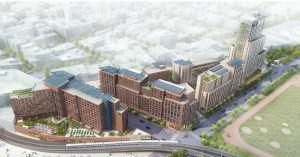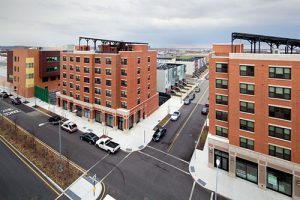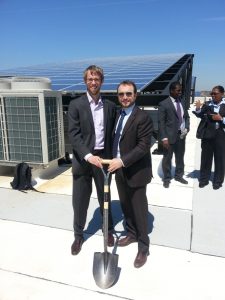The Bronx is quickly becoming New York’s favorite borough for new multifamily affordable housing developments. Bright Power sat down with Aaron Koffman from The Hudson Companies to dig deeper into why.
(Bright Power) How did Hudson Companies come to develop affordable housing projects in the Bronx after much of the firm’s historic affordable housing development activity had been in Brooklyn?
(Aaron) Hudson’s been around for 31 years now. Early on, we did work with Housing Partnership to build home ownership units in various places all over the city. Hudson built a lot of two story walk-ups, low-rises, side-by-side kind of developments that were 80-100 units, in the Bronx, Brownsville and even in Fort Greene. It was a great way to bring stability to the communities, since in many cases the land was vacant or underutilized. Then Hudson took its focus toward market-rate housing in the late 1990’s and 2000’s. We did a lot of deals in Manhattan and Brooklyn.
I came on board in 2008 and ever since we’ve focused more heavily on affordable housing. Personally, I really wanted to get us back in the Bronx. The Bronxchester RFP was announced in 2013, and we loved the site. It was mostly vacant, in a great neighborhood next to the subway and all the shopping. And so we went after it, and formed the team for La Central. Thankfully we won and have been going to the Bronx ever since.
Where we can do great work in the Bronx, we would love to do it. Of course, theBronx has become very hot so now there are areas of the Bronx that are not affordable for affordable housing, which is a problem. So we’ve known about it, and then should’ve done more, didn’t do enough, and now we’re back doing a lot.

(Bright Power) How does developing affordable housing in the Bronx differ from other areas of New York City?
(Aaron) From an economic perspective, the difference is very minor, if at all, between affordable housing in the Bronx and affordable housing in Brooklyn. Taking the economics out, there are more cases where the Bronx has better train access. We were focusing on Brooklyn so the Bronx feels new to Hudson – even if some of our fellow developers have been doing great work in the Bronx for years.
I like that it’s new to us. We keep trying to do more deals in Queens, but for one reason or another it hasn’t worked out, and so the Bronx is still sexy. Though, we love all of our boroughs equally, I love the community groups, elected officials, the incredible amount of pride, and the people and their stories in the Bronx.
(Bright Power) What role does the Mayor’s housing plan play in the increased attention on affordable housing development in the Bronx?
(Aaron) I think it’s always important when government makes a statement that they want to invest in communities. There’s an energy there that trickles down to the agencies and staff level where clearly, when the Mayor does make it a priority, the City does its best to execute that priority. For that reason, it’s great that Mayor de Blasio has made it more of a priority to put more investment into the Bronx and so has the Borough President, Ruben Diaz Jr.
The Borough President tells a great story about how his son just graduated from college, and he and his friends moved to upper Manhattan but he wants him to move back to the Bronx. He wants his Bronx kid back in the Bronx, working as an engineer and living in the Bronx, and his son wants to be there. So the Borough President is really championing investment in the Bronx, and the Mayor is too. And so everything kind of follows suit with that energy, that’s a lot of tailwind for us.
I do think the City showed their cards a little early regarding the Jerome Avenue rezoning and brought some speculators into the market that drove land cost up considerably. Not trying to criticize the administration, but that seems to be what happened. Now you have market-rate developers like Chetrit who does great work but, in the South Bronx? You know what I mean: all of a sudden, where you wouldn’t have seen a market-rate developer, there they are.
(Bright Power) Congratulations on your success on winning the Spofford RFP! What do you think differentiated your proposal for the local officials, community and the City to choose your team?
(Aaron) Obviously I can’t speak as to how we were selected, but we crafted a team for The Peninsula that was first and foremost of the Bronx. We have incredible community partners, including Urban Health Plan – one of the largest employers in the South Bronx – and The Point CDC. And I think the great retailers, in part, joined our team because of our community partners, including Spring Bank, which already has a few branches in the Bronx, and a supermarket. We can activate it at night, because Hunts Point Brewery and Bascom Catering will be there and we can cater events in our open area. We want to try to bring more people in; it’s about inclusivity.
On the development side, I love our team. Our non-profit partner, MHANY, owns many properties across the street on Spofford so they know the neighborhood and certainly have expertise in affordable housing. Hudson brings even more expertise in affordable housing and ULURPs. Gilbane has an incredible depth – they’ve been around for 130 years as a construction company and are trying to expand their New York development. And I will give a shout out to the architects BLA and WXY – they did a beautiful job designing the project. We’ve all been there before, even on the non-profit side. And when you put it all together, that’s what made us so attractive.
(Bright Power) Do you think that implementing sustainable design strategies was a big differentiator?
(Aaron) I do, it’s about sustainability, there’s no question, and it’s also about resiliency. I don’t know if Hurricane Sandy resonates in the Bronx as much as it does in Brooklyn or the Rockaways, but resiliency plays a role.
We’re in a different world where people are more cognizant of their utility use. People understand that power is polluting. Community leaders want to see that their neighborhood has the most sustainable and resilient development in the area. I’ve heard many elected officials boast about the green elements of these projects. And it is meaningful to people. I have talked to tenants of ours on other projects; they’re happy to brag about this.
At Hudson, it’s not just about us saying that we’re about the sustainable stuff, it’s that we’ve actually done it before. We know solar, passive house, cogen, and yet we still want to do one better. Also, we’re sustainable in a smart way – affordable housing depends on finite resources and we must weigh cost premiums to make sure we are doing it in an intelligent fashion.
(Bright Power) Hudson Companies was one of the first affordable housing developers to commit to implementing solar energy on their affordable housing projects. How has your view of solar energy changed over the years?
(Aaron) We’ve gone from solar being an interesting idea to solar being a no-brainer. We’ve done some great work with Bright Power in the solar and sustainability department, and the economics have only supported more investment in solar. It saves the development money, which makes the project more sustainable and allows us to put more investment back into the development.
I wish at Dumont Green we’d done a bigger solar project. Still, we’re putting in-ground and tree lighting to enhance security at night, which could happen, in part, because we’re taking electricity savings and putting it back into the building.
We see solar success every day at Gateway. I hear from a lot of Gateway tenants how proud they are when they drive down Flatlands Avenue and they see all the solar arrays up on Elton Street and they know that they live there. They are very proud that it feels state of the art. To reach 1 million watts of solar power generated at Gateway was a proud moment for our team.
We were drinking so much Kool-Aid on the solar at Gateway, which The Related Companies was a partner on, that Related has just now installed their own solar array on the Related Gateway mall. A big company like Related is always looking at the bottom line, so for them to buy in on the retail side is quite the testimony for solar.

(Bright Power) Have you noticed tangible benefits or received feedback from residents about sustainable design elements of your buildings?
(Aaron) La Central is going to be the first affordable job where we’re doing VRF (variable refrigerant flow) HVAC systems. I’m really excited to move those tenants in, even though it will not be complete until 2020, and have them find out that the air conditioner is remote controlled, it’s already installed, and their windows are as big as possible – you get all the light!
I like to ask our tenants, “You know that new apartment smell, that smell of a freshly painted apartment?” And of course they immediately say yes. Then I tell them, “Yeah, unfortunately that smell is actually bad for you. That’s off-gassing.” When they walk into our apartments, they don’t smell anything. Then, it immediately hits them – oh, these guys are doing it better. Whether it’s no VOC paint, no vinyl, or putting dishwashers in the apartments (major water savers), I see that tenants are happy to be in our developments because we’ve taken steps that give tenants respect. That speaks volumes to how Hudson does business.
(Bright Power) Many of your development projects, including La Central and Spofford, are joint ventures with non-profit housing providers. What do you look for when selecting your development partner/s on a project? Can you describe the benefits they bring to your developments?
(Aaron) Non-profit partners are essential to every affordable job that we’ve done. What do we look for? We want a real partner. We are not an 800 lb. gorilla for-profit developer. We want collaboration. We want feedback and criticism. The non-profits in NYC are incredibly sophisticated, and we want their knowledge to help inform our projects. We look for that feeling of collaboration, competency in a particular field of social service depending on the building program, or general knowledge of services/neighborhood – if we can find all three, the better.
About Aaron Koffman: As Principal, Aaron heads Hudson’s affordable housing pipeline and portfolio totaling over 3,600 units and ~$2 billion in costs. At 797 kW and spanning nine buildings, the Gateway Elton solar project is collectively the largest solar installation on an affordable housing development in New York State. Aaron is the project lead on several large affordable housing/mixed-use new construction developments in the city, including: the 992-unit La Central development in the South Bronx, the 740-unit Spofford Detention Center Redevelopment in Hunts Point, the 659-unit Gateway Elton development in East New York, and a 56-building affordable preservation portfolio in several Brooklyn neighborhoods including Bed-Stuy and Crown Heights.
Prior to joining Hudson, Aaron was a Project Manager with Forest City Ratner Companies, focusing on the 6,400-unit Atlantic Yards (now Pacific Park) residential development. In addition to serving on the Boards of the NYU Furman Center, Coro New York and the Center for Urban Pedagogy), Aaron is an Adjunct Professor of Affordable Housing Finance at NYU. Aaron received a Masters of City Planning degree from MIT and a Bachelor of Arts in Economics from UC Berkeley.
